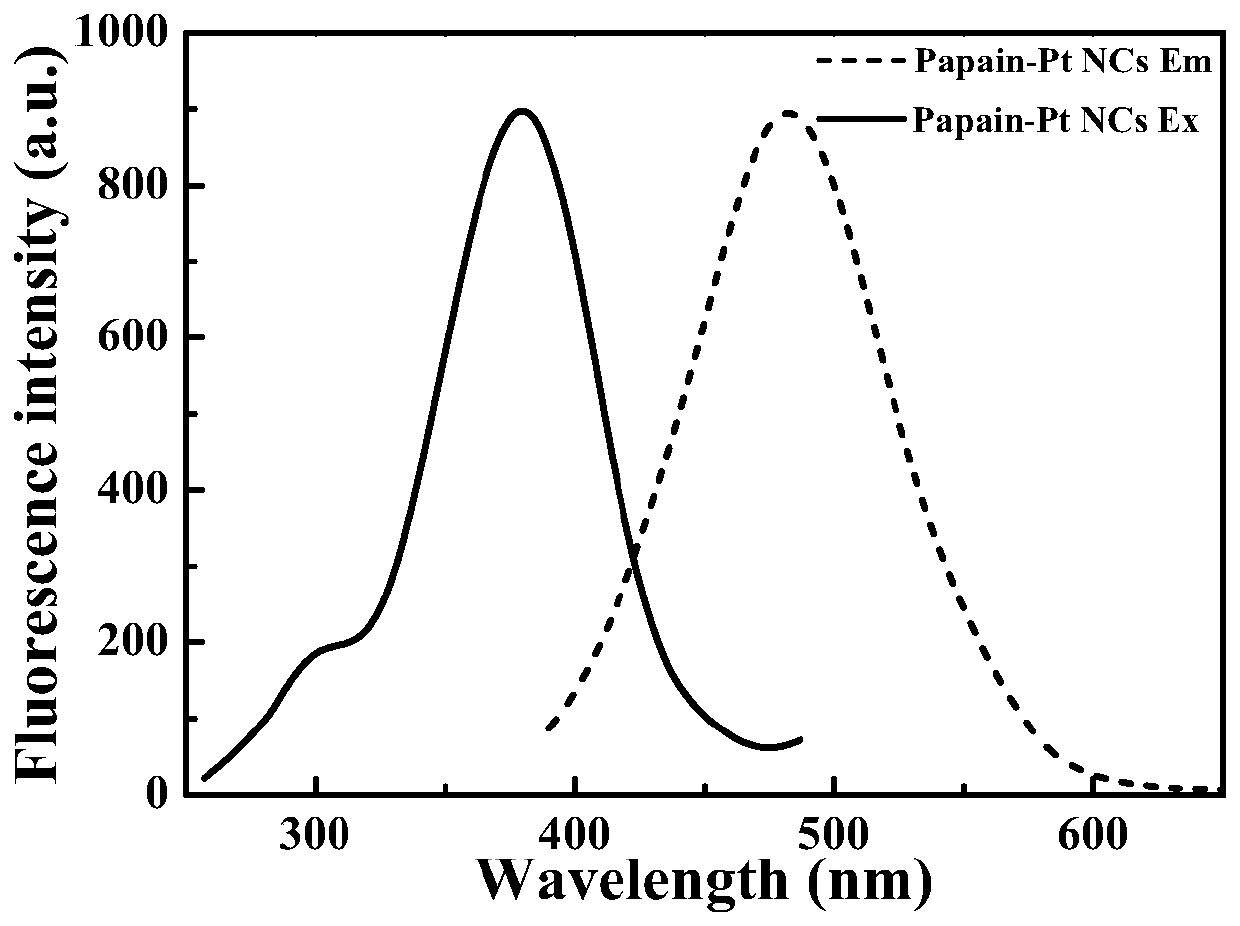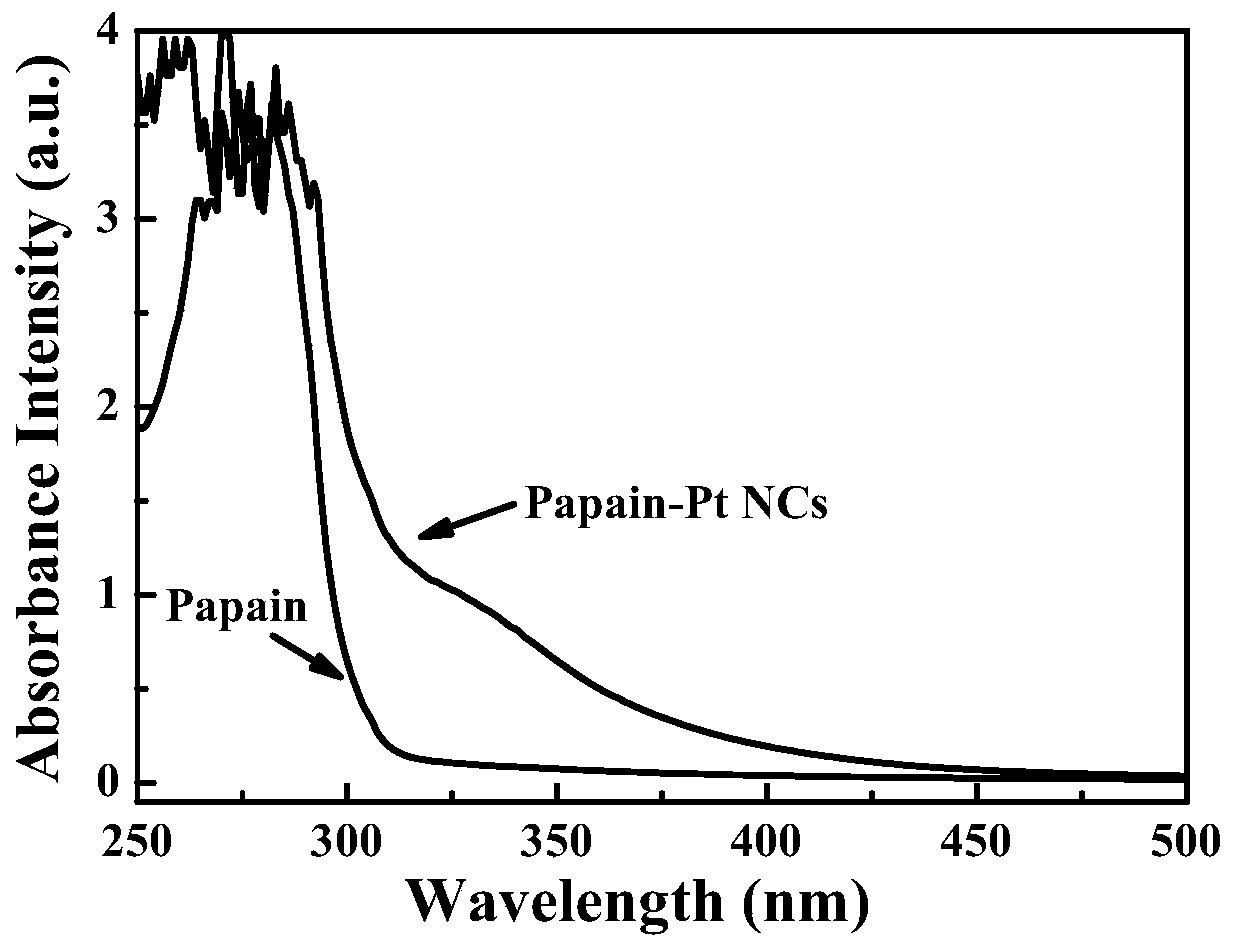Fluorescent platinum nano-cluster based on papain as template and preparation method and application of fluorescent platinum nano-cluster
A papain and platinum nanotechnology, applied in the field of fluorescent probes, achieves the effects of stable fluorescent signal, simple detection and easy realization
- Summary
- Abstract
- Description
- Claims
- Application Information
AI Technical Summary
Problems solved by technology
Method used
Image
Examples
Embodiment 1
[0039] Preparation of papain-coated platinum nanoclusters
[0040] Specific steps are as follows:
[0041] (1) Get 500mg of papain and add 10mL of pure water to prepare a 50mg / mL papain solution;
[0042] (2) H 2 PtCl 6 Add water to make the concentration of 25mM H 2 PtCl 6 solution;
[0043] (3) Add 160 μL of H 2 PtCl 6 The solution was added to 5.6mL of papain solution, so that papain and H in the mixed solution 2 PtCl 6 The molar ratio is 3.5:1, and the vortex is fully mixed for 5 minutes;
[0044] (4) Add 1M NaOH to the solution obtained in step (3) to adjust the pH value to 12, and mix again with a vortex for 5 minutes;
[0045] (5) The prepared sample was placed in a dark water bath at 37°C for 36 hours to obtain a polymer of platinum nanoclusters. After centrifugation at 5,000rpm / min for 10min, the supernatant was taken and stored in a 4°C refrigerator in the dark for future use.
[0046] The transmission electron microscope figure (TED picture) of the platin...
Embodiment 2
[0051] Example 2: Preparation of papain-coated platinum nanoclusters
[0052] Specific steps are as follows:
[0053] (1) Get papain and add papain solution in pure water to be prepared into 50mg / mL;
[0054] (2) H 2 PtCl 6 Add water to make the concentration of 25mM H 2 PtCl 6 solution;
[0055] (3) H 2 PtCl 6 The solution is added to the papain solution, so that the papain and H 2 PtCl 6 The molar ratio of the two is 2.5:1, and the vortex is fully mixed for 10 minutes;
[0056] (4) Add 1M NaOH to the solution obtained in step (3) to adjust the pH value to 8, and mix again with a vortex for 10 min;
[0057] (5) The prepared sample was placed in a water bath at 25° C. for 14 hours in the dark to obtain a polymer of platinum nanoclusters. After centrifugation at 5,000 rpm / min for 10 minutes, the supernatant was taken and stored in a refrigerator at 4° C. in the dark for future use.
Embodiment 3
[0058] Example 3: Preparation of papain-coated platinum nanoclusters
[0059] Specific steps are as follows:
[0060] (1) Get papain and add papain solution in pure water to be prepared into 50mg / mL;
[0061] (2) H 2 PtCl 6 Add water to make the concentration of 25mM H 2 PtCl 6 solution;
[0062] (3) H 2 PtCl 6 The solution is added to the papain solution, so that the papain and H 2 PtCl 6 The molar ratio of the two is 4:1, and the vortex is fully mixed for 6 minutes;
[0063] (4) Add 1M NaOH to the solution obtained in step (3) to adjust the pH value to 9, and mix again with a vortex for 8 minutes;
[0064] (5) The prepared sample was placed in a dark water bath at 65°C for 48 hours to obtain a polymer of platinum nanoclusters. After centrifugation at 5,000 rpm / min for 10 minutes, the supernatant was taken and stored in a 4°C refrigerator in the dark for future use.
PUM
| Property | Measurement | Unit |
|---|---|---|
| Particle size | aaaaa | aaaaa |
Abstract
Description
Claims
Application Information
 Login to View More
Login to View More - R&D Engineer
- R&D Manager
- IP Professional
- Industry Leading Data Capabilities
- Powerful AI technology
- Patent DNA Extraction
Browse by: Latest US Patents, China's latest patents, Technical Efficacy Thesaurus, Application Domain, Technology Topic, Popular Technical Reports.
© 2024 PatSnap. All rights reserved.Legal|Privacy policy|Modern Slavery Act Transparency Statement|Sitemap|About US| Contact US: help@patsnap.com










